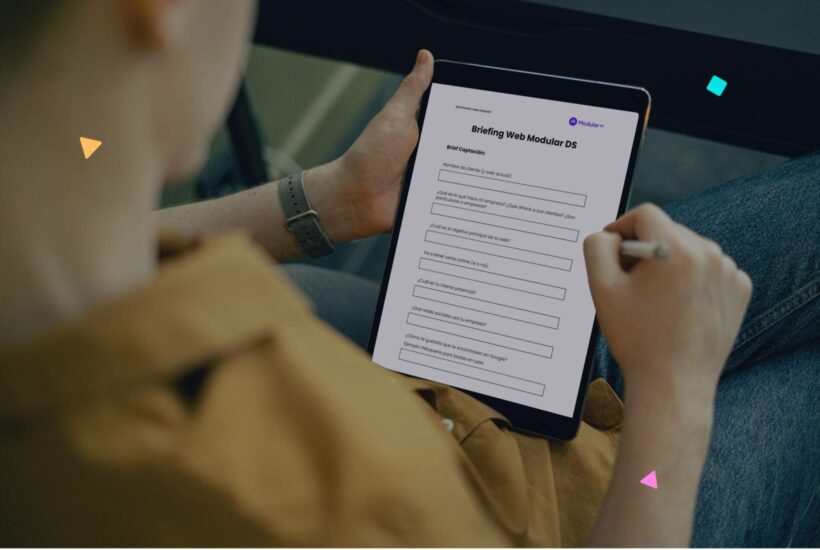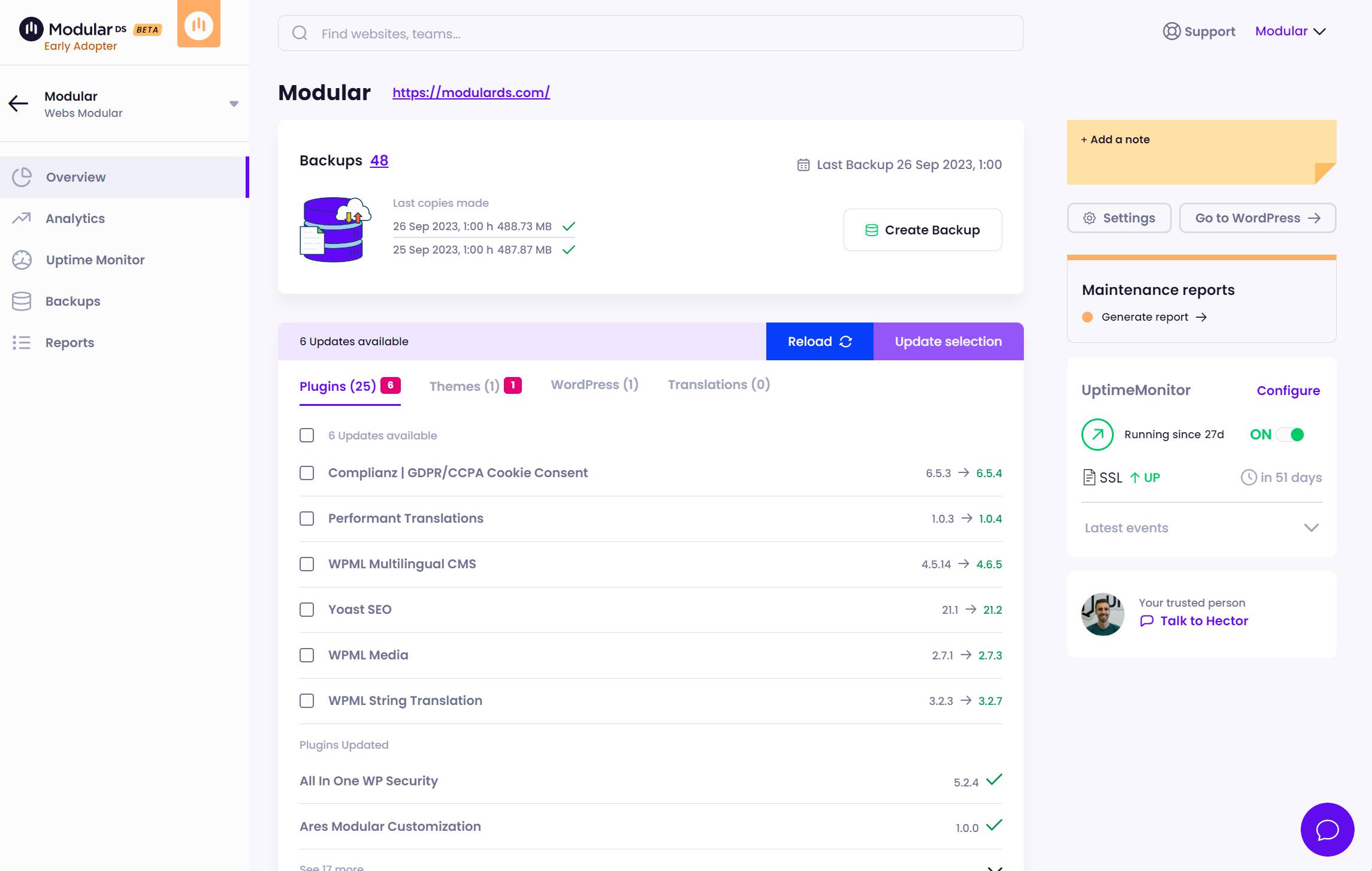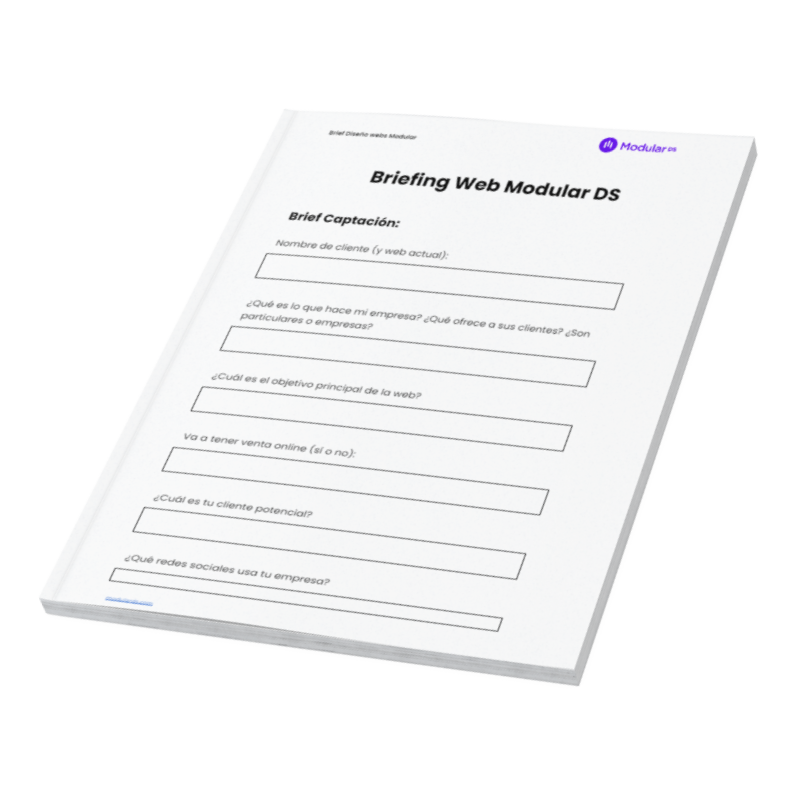Guide | How to do a client briefing step-by-step

In any web design or development project there is a fundamental initial step on which the success of the project depends to a large extent: the briefing with the client.
In this post we tell you the keys that we have learned over time and that some of the best freelancers and digital agencies use to get all the information you need from the beginning.
Find out what is the document you need to know how to prepare, its different types and the elements it should contain.
Tabla de contenidos
What is a briefing?
A project brief is a guide that contains the precise instructions for carrying out the work you are asked to do. It is the fundamental communication tool between you and the company that requires your services.
This document has a series of sections or questions common to all projects and either your client will be the one to fill them in, one by one, with the information of their particular case or you can do it together with them (which is what we like to do).
With this, we will know from their objectives to their potential client, without forgetting the format requirements, the style, and even the budget and delivery deadlines they handle. Although, let’s face it, it is difficult for the client to give you a budget in advance before you make a proposal.
Brief for a web project
The brief for a web project represents the starting point of the website you are going to design for your client.
If you choose to send it to them and let them fill it in themselves, you should ask your clients to be as specific as possible to simplify the process and avoid misunderstandings.
If, on the other hand, you choose to do it with them, either in person or in a video call, you will have the opportunity to pull the thread on the issues that you see of most interest or that may raise the most questions.
It will also give you the option to guide the client with your expertise and generate ideas that they might not have thought of on their own about how to improve their online presence.
When the brief is complete, you can start your work. You just need to pay attention to each of its sections so that you don’t forget.
Examples of briefs
There is no single brief model, just as if you are in web design or development, this may not be the only service you offer. Therefore, let’s take a look at the different variants of brief that we can find:
Advertising brief: Its purpose is to create an advertisement. Therefore, it focuses on defining aspects such as the message, the characteristics of the product, the target audience, etc.
Creative brief: It focuses more on the design than on the content. It is usually the least technical of these briefing templates.
Business brief: This gives a breakdown of the different details of the project. The objective set beforehand and the audience are two of the most important elements in this case and it has more to do with the strategy, in our case of digitalisation, of our client.
Marketing brief: This is the document that gathers the data required for the implementation of a marketing campaign. It outlines the strategy, the channels in which it is going to be carried out and the desired objectives. Both traditional and digital marketing initiatives are of particular importance.

How to make a brief for a website
Let’s get down to business. After dozens of web projects and after talking to professionals in the sector, we are going to tell you the main keys to a good briefing for the creation of a TOP website.
Take note of all of them to add them to your briefing document, or even easier, download our free template to use in all your projects from now on.

With all these keys and a few more questions.
1. Your customer’s value proposition and information
What does your client offer? Does he sell flowers or does he have a sports nutrition course? Has he been selling offline for a long time and now he is moving to the online world? Does he have a previous website?
This is all information you need to know about your client’s company or brand in order to think about the project as a whole.
If you consider it relevant, you can also include information on how long it has been in operation, its history, the location of its head office, etc. All this description will allow you to get to know the company better, especially if you have not worked with it before.
2. The objective(s) set
What objective has your client set for the web project? Does he want those who access his web page to contact the company? Is he trying to improve his image and optimise his presence on the web? Is he looking to build customer loyalty? Or perhaps he wants to sell products or services directly on the site?
The answer to these questions will guide everything else. You can have a single goal or, on the contrary, several equally important ones. Although it is certainly better if there is a main objective to which you give more importance.
3. The target audience
The target audience refers to the audience that your client’s company is trying to reach, and is something you need to know.
It can be other companies (B2B) or individuals (B2C). And within this second group we can differentiate between men and women or between teenagers or parents, who nowadays, we could say, speak almost a different language.
Their interests, such as, for example, their concern for sustainability, their love of sport, their desire to follow fashion trends, etc. are also very useful for targeting your main CTAs (Call to action) or featured sections.
Today it is very common to create what is called a customer persona to understand in depth the type or types of customers that the business may have.
4. Contents and structure of the website
Here you will try to draw out the information and contents that should appear on the website, how to structure it and how to create a sketch of the navigation tree of the site. This is essential to begin to visualise the page itself.
The requirements section is the space where you will have to go into the most detail with all the indications you want to record. The more detailed the text written by your client, the better chance you have of successfully adapting to his idea. In this way, you will avoid possible corrections or changes that would force you to devote more time and effort to the project.
Normally, if your client has documents such as a company dossier, advertising brochures, or a website already created, you will have a small guide to start from.
5. Possible restrictions or limitations
This refers to those red lines that should not be crossed, as they may lead to sanctions or loss of credibility with the public. It will take into account the country’s laws, industry and other regulations. It will also address issues that need to be considered from a moral point of view.
These may be words, expressions or images that must be avoided at all costs. Your client should define these restrictions or limitations from the outset.
6. The style guide and audiovisual material
It is likely that the entity created by your client already has a defined corporate image. It is sure to have a logo, a characteristic typography, a colour palette and other signs of identity.
In addition, it is very important to know if they have photographic or video material or if they prefer to use stock photos.
Ah, important. Warn your client not to send you the photos via WhatsApp, as they lose quality and then complain that they don’t look pixel perfect on the web.
7. Description of the stakeholders
This is a list of all the people who are directly involved in the project. With small companies it is usually only their owners or managers, but in larger projects you should know all the people involved and have their contact details.
This information will help to coordinate the work. It will also help to save time by not having to play “who’s who” when you need to contact someone during the project.
8. A selection of direct competitors
Knowing what the competition is doing (don’t let your client say they don’t have any because we all do) is very interesting.
It gives you the opportunity to study their strengths and weaknesses and, above all, to get to know a sector with which you are probably not familiar.
The knowledge you acquire will help you to improve your final proposal and to discover how your client can differentiate himself from the rest.
9. The available budget
This refers to the amount of money that your client has decided to allocate to this work. The figure should be as concrete as possible, so that you can know the limits of your budget before implementing certain actions. This way you won’t be afraid of going over budget.
As we have already said, this is almost mission impossible and many times it makes you work on a proposal with a lot of care and enthusiasm only for your client to tell you later that it is too far from their budget. Therefore, try to at least know the range in which they would feel comfortable in order to adapt your proposal to that. We already know that a website is not something closed and that it can be done in many ways.
10. Deadlines
“Yesterday”. Or so almost all clients seem to say. They are all in a hurry but then when you ask them for things that you need from them, they miss it a bit.
Anyway, this point is key. Here you define the deadline by which the work will be completed or a timetable with different dates. The latter will respond to successive deliveries of the different versions of the project, or to the execution of the different actions planned.
The timetable will help you to organise yourself so that you can fulfil the commitments you have made to your client without any problems.
Conclusion
As you have seen in this article, with a good briefing you can get to know your client, their business and their objectives and expectations.
Something very beneficial for him, because your work will be much more adapted to the website he wants or needs and also very beneficial for you, because it will facilitate the process of ideation and design of the website.
Let’s not forget that as digital professionals we work on projects in very different sectors in which, in general, we do not have any experience.
Performing this step before each project will ensure that both we and the client are clear about the guidelines and objectives of the project. This will allow us to advance along the same lines, ensuring the quality of the final result.


